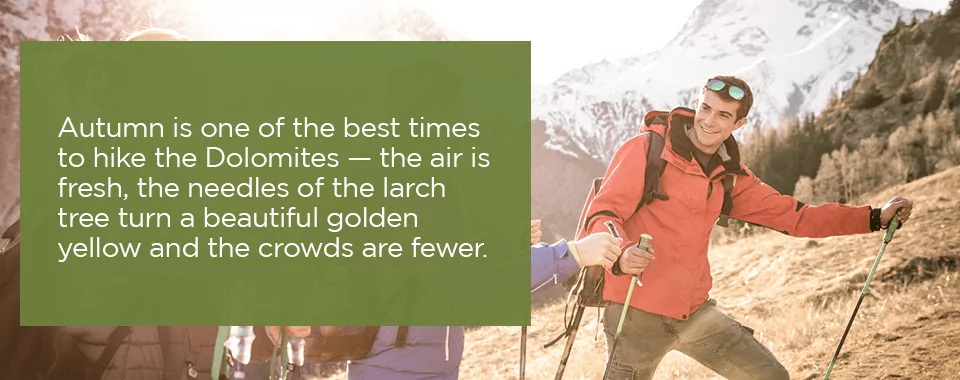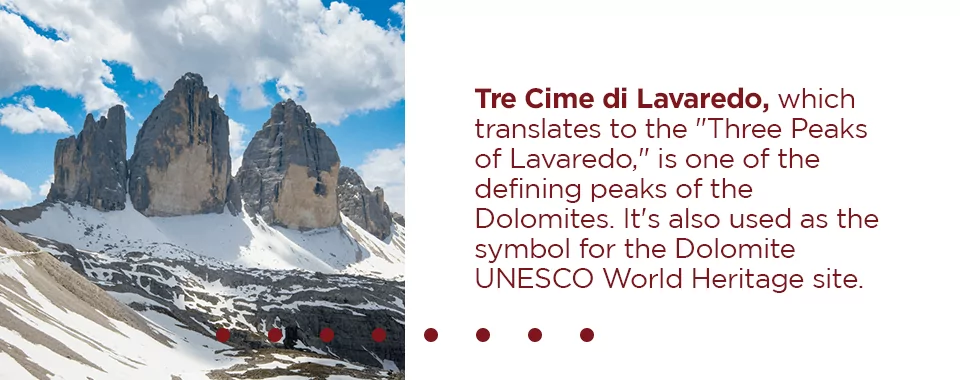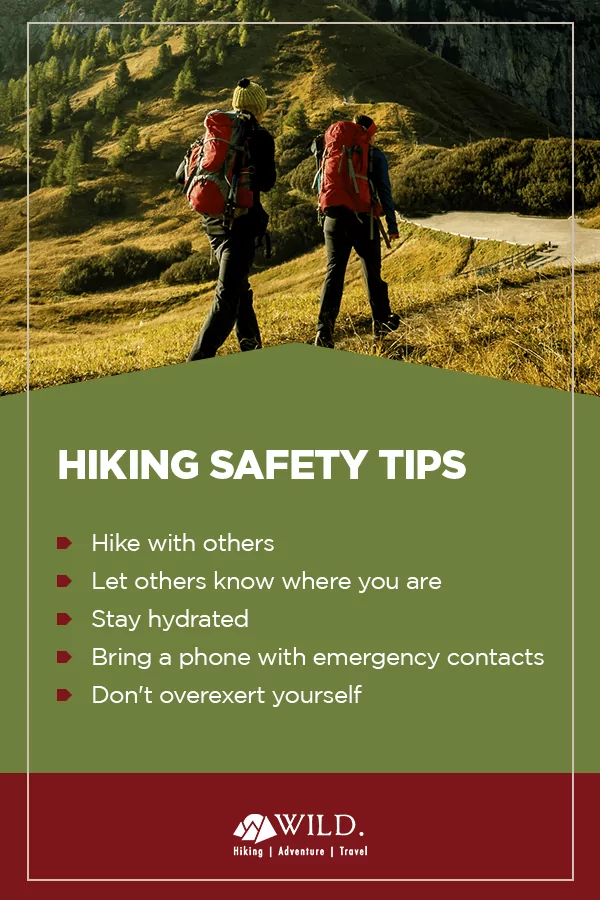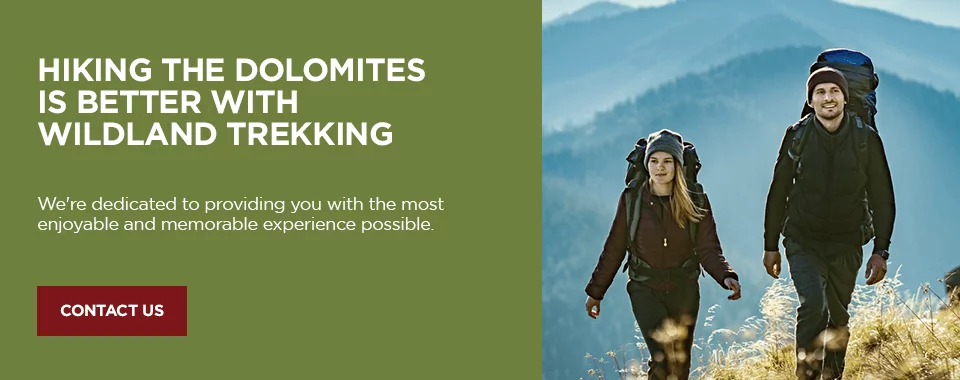Dolomites Hiking

Known for its dramatic, rocky cliffs that overlook verdant valleys and ancient villages, the Dolomite region of Italy is a bucket-list destination for hikers worldwide. To prepare for an excursion to this stunning range — and to get some inspiration for your perfect itinerary — we’ve put together this handy guide of Dolomites hiking tips.
What to Expect
Whether you’re planning your first hike or your hundredth, it pays to prepare. While the range is open to people of any skill level all year long, keeping this information on seasonality and difficulty levels in mind will help you make the most of your expedition.
When to Hike the Dolomites
Due to its temperate climate, the Dolomites are a great year-round tourist destination. Each season offers something different:
- Summer: If you prefer to stay active on your trips, summer is an excellent season to visit the region. You can enjoy many outdoor activities, including mountain biking, road biking, climbing, hiking and via ferrata. A network of hiking trails allows you to explore the region in depth. The mountain huts — known locally as rifugi — are open throughout the summer, so you can take multi-day hikes or stop for a meal while hiking. Numerous music festivals abound, and cycling fans can also observe bicycle races such as the Maratona dles Dolomites or participate in the Sella Ronda Bike Day.

- Fall: Autumn is one of the best times to hike the Dolomites — the air is fresh, the needles of the larch tree turn a beautiful golden yellow and the crowds are fewer. It’s also a great season for photographers. Shadows are longer, and the rock formations turn a beautiful rosy pink and golden orange right before sunrise and after sunset. If visiting in early September, you can go to Canazei to catch the Gran Festa di d’Ista — a three-day event celebrating summer’s end — where you can experience the music, food and other cultural traditions of the Ladins.
- Winter: This high-altitude mountain range provides great opportunities for snowboarding, skiing and various other winter sports. Boasting world-class ski resorts and having hosted the Winter Olympics, the Dolomites are an excellent winter sports destination for beginners and professionals alike. The region also enjoys sunnier weather than other regions of Italian Alps hiking.
- Spring: In the springtime, the snow melts to reveal the Dolomite’s famous limestone. Pastures turn green, and wildflowers abound. The biking and hiking trails open up once again, and the Dolomite walls and via ferrata are again ready for you to climb.
Hike the Dolomites with Award Winning Guides
Hiking Difficulty
Hiking the Dolomites often involves ascending and descending thousands of feet in elevation per day. Eighteen of the range’s peaks rise to impressive heights of 10,000 feet or more. Thus, it’s best to come physically prepared. We recommend the following aerobic activities to prepare yourself for your Dolomites hike:
- Running
- Hiking
- Swimming
- Stretching
- Strength exercises
Best Hikes in the Dolomites
The Dolomites offer various single- and multi-day hikes, the most popular of which include:
1. Adolf Munkel Trail
The Adolf Munkel train provides some of the Dolomites’ most spectacular scenery — and it’s comfortable for people of many skill levels to navigate.
This circular hike begins in Villnösstal, also known as Val di Funes, and heads toward Tschantschenon. As you walk along the gravel road, you’ll pass by several B&Bs and small restaurants. The trail is well-marked, so you can easily find your way.
The first section of the hike goes uphill and offers minimal shade, so remember to pack your sunscreen. You will soon get to a bridge, where you’ll turn right to stay on the Adolf Munkel trail. This section, Trail 35, is rather easy to hike and offers beautiful views.
You’ll then arrive at an intersection with Trail 36A, which leads to a picturesque alpine hut called Geisler Alm. You have the choice to turn here or continue toward Trail 36, where you can trek to Gschnagenhardtalm — another attractive mountain hut. If you continue along this trail, you’ll also reach the Geisler Alm.
Geisler Alm makes for a fantastic spot to kick back for a few hours. It includes a large playground, a restaurant and an inviting outdoor seating space. Take in this dramatic scenery while enjoying a meal or some local apple strudel.
Once you feel rested and replenished, you can get back on the trail and head toward Dussler Alm and return to the parking lot where you started — all in a day’s trip.
This 9-kilometer loop trail is of moderate difficulty and takes about three hours to hike. You can also access it by public transport — just take a bus from Chiusa bound for Zanserhütte.
2. Seceda to Pieralongia
This circular hike is another great option for those wanting to take in breathtaking views with minimal exertion. Ortisei’s Seceda cable car station is its start and endpoint. Once you exit your cable car in Seceda, you’ll head toward Seceda Mountain’s unique shape in the distance to go to Pieralongia. As you turn onto Trail 2B, you’ll soon get your first sight of Pieralongia’s distinctive long, sharp rocks.
While the views here are stunning, you can take a quick scenic detour by turning left on Trail 6 if you’d like to catch some good views in the opposite direction. It offers great sights of Puez-Odle Nature Park’s northern parts.
When you reach Pieralongia, you’ll come across the Malga Pieralongia Alm, an authentic mountain hut with surroundings so inviting that you may be inclined to spend a few hours here. The hut includes bathrooms, restaurants, a playground and even a few farm animals — which your children are sure to enjoy.
If you choose to hike beyond the hut, you’ll get an up-close view of those oddly shaped rocks you saw from a distance at the beginning of your hike. You may even encounter some donkeys along this section. The scenery is stunning — if you brought some food along, this will be a great place to stop for a picnic.
The Seceda-to-Pieralongia hike is an excellent choice for anyone looking for a relaxing, scenic excursion with an abundance of huts and other facilities. This 4-kilometer route can last anywhere from one to three hours depending on how many stops you make at restaurants and playgrounds. It’s also easily accessible by bus.
3. Tre Cime di Lavaredo

The hike to Tre Cime di Lavaredo is found in practically all hiking guides for the Dolomites and is widely considered among the region’s top hikes. Tre Cime di Lavaredo, which translates to the “Three Peaks of Lavaredo,” is one of the defining peaks of the Dolomites. It’s also used as the symbol for the Dolomite UNESCO World Heritage site.
This loop trail begins at Rifugio Auronzo. Make your way past the eatery, and you’ll see a gravel road that leads toward Rifugio Lavaredo. Halfway there, you’ll come across a small chapel called Cappella degli Alpini. This first section of the trail — which is 1.7 kilometers one-way — is easy and flat. So, it is usually quite crowded.
Once you pass Rigufio Lavaredo and head toward Forcella Lavaredo, the trail becomes a bit steeper and more strenuous. This section is much less crowded. After Forcella Lavaredo, the trail heads toward Rifugio Locatelli, where it becomes flatter and easier once again. The section is roughly 2 kilometers long and will take most hikers roughly 40 minutes.
When you pass Rifugio Locatelli, you’re roughly halfway finished with the loop trail. The next stop, Malga Langalm, is 3 kilometers down the trail. From there, it’s a quick hike back to your starting point.
This 9.5-kilometer hike will take anywhere from three-and-a-half to five hours and is of moderate difficulty. This hike is perhaps the park’s most popular, so crowds can be large during the summer — especially on the weekends. If you’re flexible and would like to hike more vacant trails, try coming during the off-season or on a weekday.
4. Catinaccio to the Sciliar
This epic four-day hike begins in Nova Levante, located in the Val d’Ega, and wanders through meadows to the well known Hirzelweg Trail. This trail, in turn, leads to the famous Christomannos monument. Here, you can spend the night in the Rigufio Roda di Vael.
On the second day, you’ll ascend to the Passo Cigolade, after which you’ll descend to the Rifugio Vajolet, where you can spend the second night. Once you check in, you can climb up to the Passo Santner if you feel up to it.
You’ll begin your third day by crossing the Passo Principe, after which you’ll come across the Alpe di Tires and Rifugio Bolzano. The last stretch of the day will ascend to the Monte Petz, which opens up a gorgeous panorama to the surrounding peaks.
On the fourth and final day, you’ll descend from the Sella Cavaccio to San Cipriano. The Valle Nigra path will bring you to the Passo Nigra and then take you back to your starting point.
This 52.1-kilometer hike is fairly challenging and requires good stamina and alpine hiking experience.
Tips for Hiking the Dolomites
Maximize your comfort, safety and enjoyment in the Dolomites by following these tips:
What to Pack
Make sure to wear or bring along the following when hiking the Dolomites:
- High-quality backpack:Whether you opt for a single-day or multi-day hike, you should buy a sturdy backpack. You could encounter unexpected harsh weather at any time of year, so your pack’s quality is of the utmost importance.
- Hiking pants: These should be comfortable, and the length will depend on the time of year you visit.
- Light shorts: You can use these when relaxing in the rifugios.
- Thermal layers: Bring long pants and tops for chillier days and nights.
- Sweater: Your sweatshirt should have long sleeves and a hood.
- Down Jacket: Any jacket you bring for your hike should preferably be lightweight.
- Rainproof gear: Make sure to take along rainproof pants and a windproof jacket.
- T-shirts: We recommend you bring two or three extra shirts.
- Underwear: Bring whatever amount of undergarments you feel comfortable with.
- Headwear: A wool hat is ideal if the weather’s colder.
- Hiking boots: When hiking in Italy, the only option for footwear is high-quality, sturdy hiking boots. You may also need to bring along climbing shoes, depending on the amount of climbing you’re planning on doing. Slip some lightweight, comfy shoes into your bag that you can wear after a day of intense hiking.
- Hiking socks: This is one of those easily forgettable items that make a big difference in comfort. If you are known to blister, we recommend taping up each of your toes or wearing toe socks.
- Climbing equipment: If you plan to go on a via ferrata, you’ll need ropes, climbing shoes, a helmet and related equipment.
 Hiking Safety Tips
Hiking Safety Tips

You’ll also want to familiarize yourself with these best safety practices:
- Hike with others: If you’re not part of a guided tour, make sure you’re always hiking with a partner.
- Let others know where you are: Let someone else know when they should expect you, whether it be your hotel’s front desk or others traveling with you.
- Stay hydrated: Have a bottle of water on you throughout the hike. At high elevations, you perspire and exhale moisture at a greater rate than you do at sea level.
- Bring a phone with emergency contacts: While you may assume you won’t get any reception in the mountains, the mobile service in Italy is excellent. Emergency contact numbers should include those of your tour operators, your rifugio or destination hotel and emergency services in the area.
- Don’t overexert yourself: The Dolomites can be a challenge for even experienced hikers. Make sure to pace yourself and be careful. Remember to take a few breaks throughout your trek — an easy task considering the gorgeous scenery that surrounds you.
Don’t Miss
Here are some of our must-see recommendations in the Dolomites:
- Enjoy a mountaintop view: Whether you get there by gondola or on foot, don’t leave the Dolomites without making it to the top of one of its stunning peaks.
- Experience WWI history: Quite a few trails at the Dolomites pass World War I artifacts and relics, including a museum and tunnels built into hillsides.
- Consider an autumn visit: Hiking the Dolomites in the fall is an otherworldly experience. You’ll enjoy clean air, breathtaking views of the larch trees and vacant trails to traverse.
- Explore the villages and pastures: In addition to its stunning natural beauty, the Dolomites also have many ancient villages and quaint farms that you can explore.
Hiking the Dolomites Is Better With Wildland Trekking
Wildland Trekking offers an eight-day hiking tour through the Dolomites that covers the best of what the region has to offer — including the Sennes Range, Antorno Lake and Tre Cime di Lavaredo. We’ll also take care of everything during your trip — including gear, meals and accommodations — so that you can spend more time enjoying your vacation.
Perhaps the greatest aspect of our company is our friendly, expert guides. At Wildland Trekking, we’re dedicated to providing you with the most enjoyable and memorable experience possible — all while adhering to strict safety protocols.
If you would like to find out more about our Dolomites itinerary or other international hiking trips, feel free to reach out to us via our contact page.





